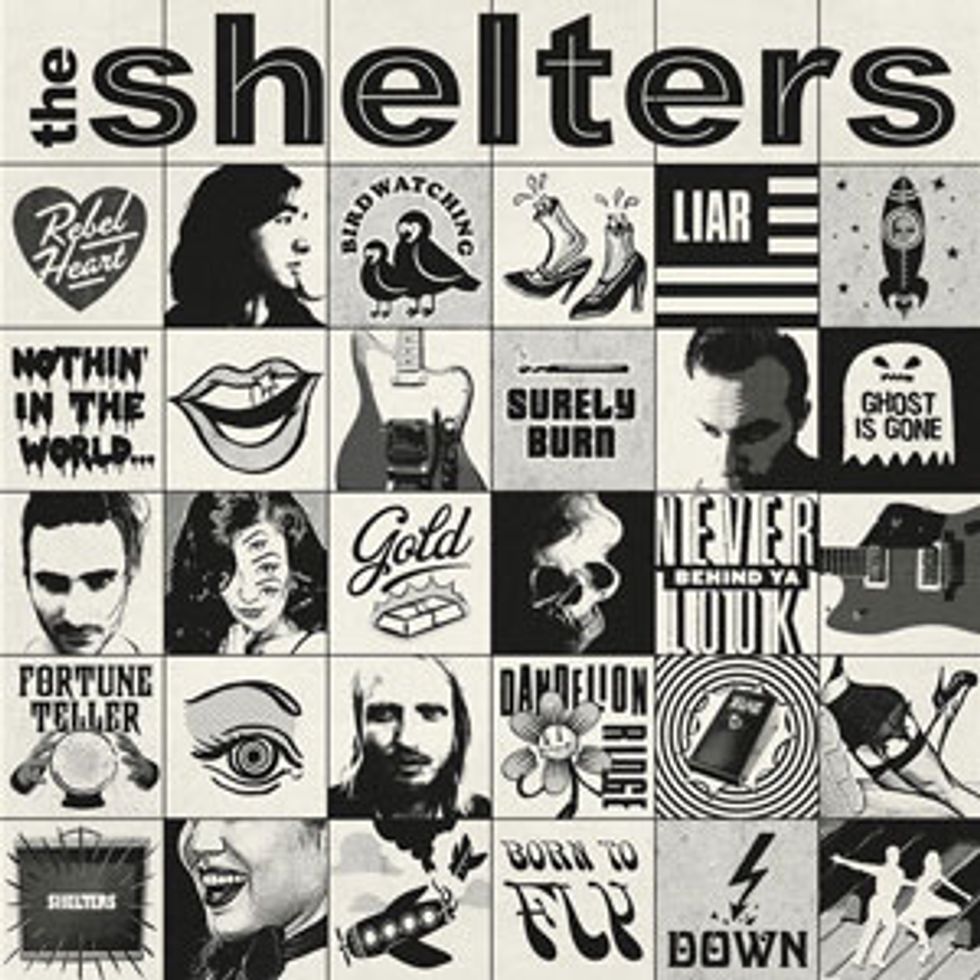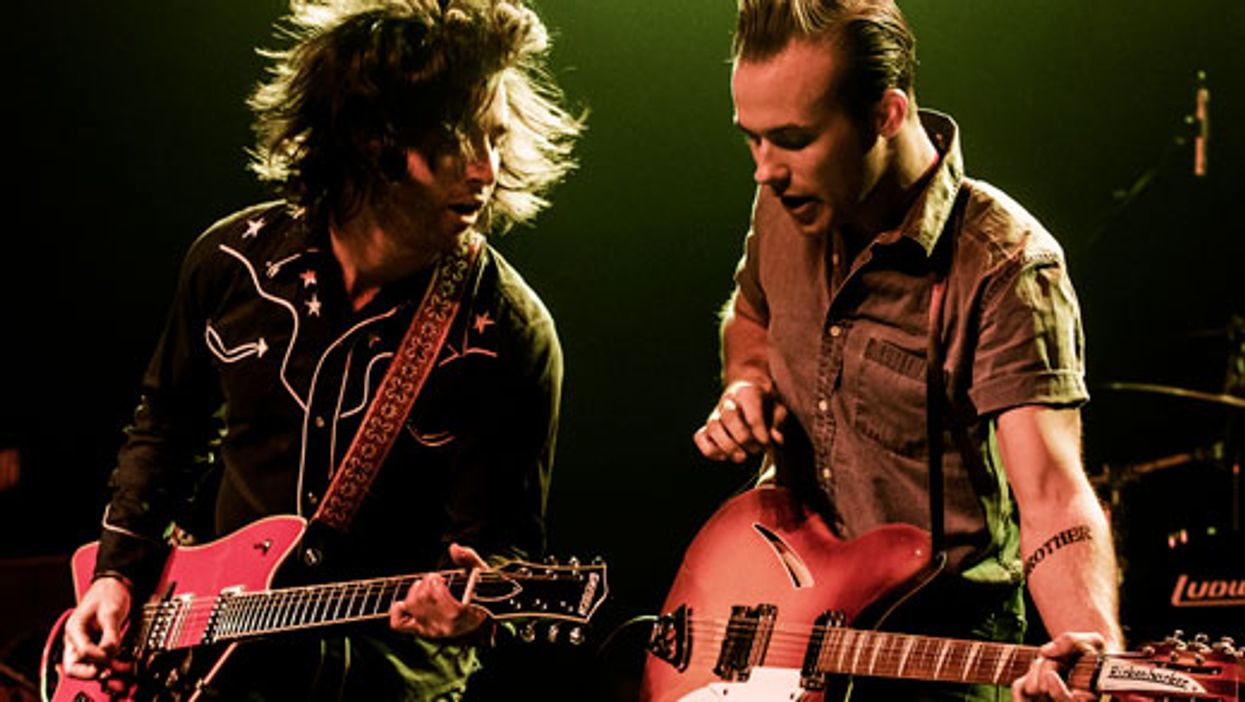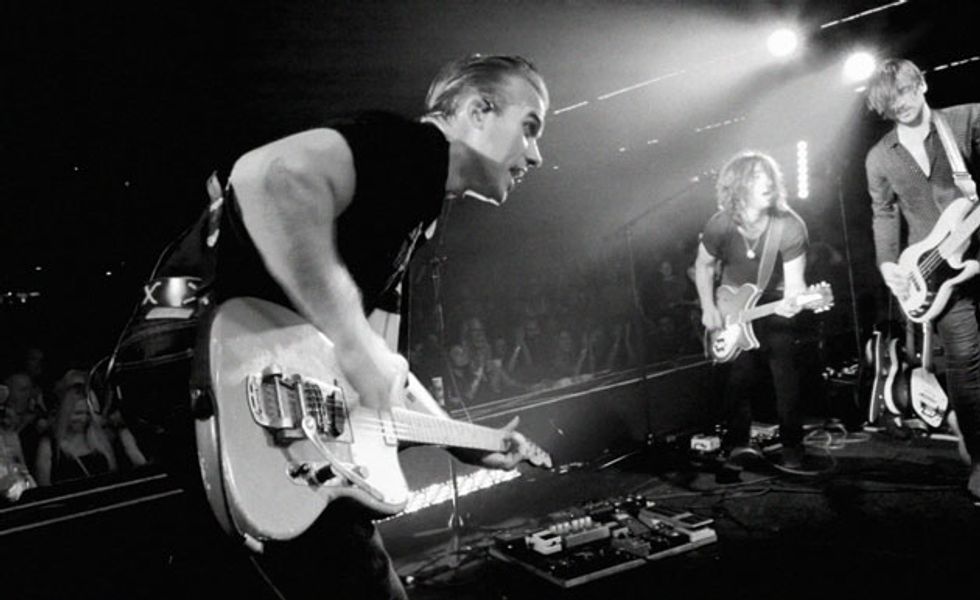A few years ago, Tom Petty saw the Shelters perform live in Los Angeles and was so impressed with their sound and performance that he decided to take them under his wing and co-produce their self-titled debut. And while the notoriety gained from being mentored by such a rock icon is welcome, and even beneficial, the Shelters are in no way a vanity project. Petty gave them the keys to his studio and allowed them to hone their craft and develop the potential he witnessed on that fateful night. “We're lucky to have a great relationship with Tom," says singer and lead guitarist Josh Jove. “He turned us on to so much cool music and produced our record, but he wasn't too hands-on. He let us explore on our own, but his influence is undeniable."
That influence, and those explorations, manifest themselves in an electrifyingly cohesive blend of British Invasion and California surf music on The Shelters. “We really love all the California bands, and there's some overlap with the British Invasion bands, so our sound becomes its own unique thing," Jove explains. “Sometimes people have a hard time placing it because they either hear the Beatles or they hear more of the California vibe, like the Beach Boys." Indeed, a song like “The Ghost Is Gone" has an Animals-meets-the-Doors slant to it, while their first single, “Rebel Heart," with its 12-string guitar intro, recalls the Byrds, but with West Coast undertow rhythmically and melodically. Vocally, “Fortune Teller" is pure John Lennon-esque Beatles, but, harmonically speaking, the progression is a bit more American sounding, like something you might associate with Tom Petty himself. Petty's mentorship may have garnered the headlines and given them a tremendous opportunity, but it's by no means the bedrock on which the Shelters' sound was forged.
As for the guitar parts, Jove and co-vocalist/rhythm guitarist Chase Simpson weave in and out of one other in ways not unlike the Rolling Stones, who made that style of interplay famous. The intro to “Down" is a prime example of this kind of herky-jerky rhythmic feel. Jove handles all the lead guitar work and his solos are direct, in-your-face expressions, like little squawking songs within the song. Think Dick Dale meets George Harrison.
like it to be in concert."
The Shelters were formed in Los Angeles in 2015 when Jove, Simpson, and drummer Sebastian Harris left their previous outfit, Automatik Slim (a band that featured Petty's stepson, Dylan Epperson Petty) and enlisted bassist Jacob Pillot. They cut and released their debut EP, simply titled EP, that same year. Since then they've been on the fast track. PG caught up with Jove, who was at home in L.A. between tour dates, to talk about recreating their debut album in a live setting, working with Petty, and the pleasures of recording with vintage gear.
How involved in production was Tom Petty? Did he help with arrangements and sounds?
He loved talking about sounds just as much as any musician. Most musicians I know are into making cool sounds in the studio. But mainly, he would give us input on the songs. He's such a master songwriter. We would spend a lot of time getting cool guitar sounds or getting some wild fuzz sound, but if there wasn't a song behind it, he'd be the first one to say, “Well, that's a cool sound, but where's the song?" That's where his input was critical: making sure these songs were memorable and good and universal.
At what stage of the process were you getting such feedback?
At rehearsal. He would come in and say something like, “These lyrics are a little too literal. You guys should explore some more poetic options." And he would kind of leave it at that. He'd walk away and leave us sitting there going, “Well, how are we going to impress him?" We'd come up with things until he thought it was great. And then he would say, “That's a good song. You guys got it. Now you can work on the fuzz sound."

On The Shelters, the band employed a '70s Maestro Echoplex EP-3 as their sonic secret weapon. “We used that on so many things on the record—simple vocal slap-back echo, sound effects, drum sound effects—you name it," says Josh Jove. “It was kind of a magic box. I would love to bring that out live. It's become an important part of our sonic signature, but I would never do it because it's just so unreliable. I have an extensive pedalboard that allows me to capture a lot of that stuff."
Why do you think you guys connected so well with him?
The stuff he's into is not very different than what we're into. He loves British Invasion bands; he loves California rock 'n' roll music. And I think, even though he's from the South, he's become the sound of California. I think a lot of people associate him with that and American music. He's been a huge influence.
And you're originally from Florida, as is Tom.
Tom has always been the king of rock 'n' roll to me. Growing up in Orlando, a lot of bands I played with sounded like they wanted to be Tom. That was the thing. Then I moved to California and got to work with him. It's been great to pick his brain and hear the music he's into.
You recorded at his studio?
Yes. We recorded at Shoreline Recorders. It's not where the bulk of his recent material was recorded, but he's been doing overdubs there for years. When we started our record, the studio had been dormant. It hadn't really been used because he has another studio. We dusted everything off and reinvigorated the studio and made our record there over the course of a couple of years.
Was there a lot of cool gear in his studio?
The amount of gear used on the record is staggering. Not only are there tons of instruments at the studio, but there was also a revolving door of instruments. Some days we'd walk in and there would be some new guitar sitting there. I'm a real enthusiast when it comes to guitars, so when I see a specific guitar I associate with a certain guitar player, like a famous, historical, rock 'n' roll guitar player, all I can think is, “Let's go write a riff that sounds like that." In a lot of ways, the gear influenced the writing process because it was like, “This guitar has a Pete Townshend vibe, so let's make this a Who part and record it with this guitar." The gear sometimes dictated what direction we'd take the arrangement.
Josh Jove's old mainstay is a guitar he put together with a Telecaster neck, a Jazzmaster body, and a Bigsby. “For me, the only real requirement is to have single-coil pickups and a Bigsby," he says. “I use the Bigsby very gratuitously."
Photo by Pamela Littky
Can you give us an example of gear influencing a song?
We have a song called “Down" on the record that has a heavy instrumental bridge. It was just a riff for a while, but I started playing it a little higher, almost like a guitar solo, and it acquired a Cream vibe to it so I was like, “What's the closest we can get to an old-school Cream type of thing?" And we looked around the studio and there was a '60s Gibson SG that's probably very close to what Eric Clapton was using back then. I was going for that Clapton-type of “woman tone," which is typically using the neck pickup with the tone knob rolled off completely for a big, fat sound. I ran that into a treble booster—I can't recall the amp we used. I wouldn't say I nailed the Clapton sound, but half the fun in the studio is trying to recreate sounds that I love and not quite getting there.
How do you and Chase Simpson arrange guitar parts?
Chase is really into rhythm guitar. That's his thing. The guitar players he loves are just pure rock 'n' roll, like Malcolm Young and guys like that who can just hold it down. We both love the Rolling Stones and the way they interweave their guitar parts. Chase will usually play more of a cool, rhythmic guitar riff and I do more of the jangly, high, fuzzy-type of stuff and we just make them intermingle.
You employed a wide palette of instruments on the record. How do you recreate those sounds live?
We played a hundred-something shows this past year and the entire goal was, “How do we make this record a reality onstage?" The live show is more meat and potatoes sonically—we figured out how to make it work. Chase has a very specific, cool rhythm guitar sound that he dialed in. He mainly uses a Gretsch Billy-Bo guitar that provides a nice rhythm-crunch sound—something not that far off from Billy Gibbons or Angus Young. It's a nice mid-range sound. So, that works for most of the things that he's playing in the set, which is a lot of cool, chordal stuff.
What about you?
For a while I was playing a guitar that I put together out of different pieces. It was a Telecaster neck with a Jazzmaster body and a Bigsby. For me, the only real requirement is to have single-coil pickups and a Bigsby. I use the Bigsby very gratuitously. Lately I've been using a Gretsch Duo Jet—a George Harrison model that fits my qualifications of a single-coil guitar with a Bigsby. I go for a twangy guitar sound live and use fuzz pedals for lead stuff. That's all I really need. Between that and tweaking the knobs on the guitar, I'm able to get most of the sounds from the album.
What about amps?
Live, I use a Fender Showman. It's a 100-watt amp with a 15" speaker. It's the amp that Leo Fender created with Dick Dale. I love surf guitar music and Dick Dale is one of my favorites.
That amp explains why your leads are so punchy live.
It's good to be able to overtake the whole stage sometimes. The music we love is from the '60s and guitar solos aren't tastefully in the mix; they're right in your face. And that's how we like it to be in concert.
So, essentially, you take a more utilitarian approach on the road?
Absolutely. And I treat my equipment just like tools. At the end of a tour they're beat up and in need of repair. I try not to take the most precious things on tour. An important part of our record was this specific '70s Maestro Echoplex EP-3. It has a red faceplate which I've only seen a couple times. We used that on so many things on the record—simple vocal slap-back echo, sound effects, drum sound effects—you name it. It was kind of a magic box. I would love to bring that out live. It's become an important part of our sonic signature, but I would never do it because it's just so unreliable. I have an extensive pedalboard that allows me to capture a lot of that stuff.
Josh Jove's Gear
GuitarsGretsch G6128T George Harrison Duo Jet
Rickenbacker 360/12
Frankenstein Jazzmaster
Amps
Fender Showman piggyback with 1 X 15 cabinet
Effects
Analog Man Beano Boost treble booster
Maestro Fuzz-Tone
Boss VB-2 Vibrato
Boss DD-3 Digital Delay
Diamond CTP1 Counter Point delay
Strings and Picks
D'Addario EXL115 (.011–.049)
Dunlop 421P Ultex 1.0 mm
How do you split your sounds between effects and amp?
I try to keep the fuzzy, modulation stuff on the pedalboard and I like the amp to be crunchy and have the reverb available if I want to go down surf territory. I can get most of the sounds on the record with pedals. I can get the rockabilly slap sound, I can get a funky Leslie vibrato sound, and I run a Fender reverb tank into the Showman for the surf elements.
What effect are you using on “The Ghost is Gone?"
It's an old Vox Ultrasonic guitar that has the repeaters built in. It has a more Spiritualized kind of sound, but it also has a built-in fuzz that layered well with the pedal-steel part. And that fuzzy, wicked fast repeater sound is so cool. Link Wray is one of my favorite guitar players and I always liked the way his tremolo got more extreme and changed speed. On the Vox Ultrasonic, you can play a little lick and then change the speed of the vibrato while it's sustaining. I do that on that song—I'm constantly messing with the speed of it. You'll hear it chopping in and out at different speeds whenever that guitar part comes in.
“Rebel Heart" has a cool 12-string part that recalls the Byrds.
That's a 12-string Rickenbacker. That was the first song we wrote as a band and it wasn't always a 12-string part. It was more of a regular 6-string guitar part, but once we picked up the 12-string it took on a whole new life.
You mentioned Link Wray and Dick Dale already. Who are some of your other influences and what is it about them that inspires you?
Hank Marvin, Jeff Beck, Jimmy Page. I love guys that do cool sonic things on the guitar. Les Paul. People who were pushing the envelope sonically, not just the way they played. They all created something unique. Dick Dale created an entire sound. Now it's become so common people just associate it with the beach and California. Jeff Beck is a mind-bending guitar player.
Your solos are exercises in minimalism, like little songs within the song.
That's something I always strive to do. It's my George Harrison influence. I feel like that was his specialty. You could sing his solos. It's almost a cliché amongst guitar players, but you don't want a solo that somebody can't relate to. If you think about any instrument, even a big drum fill from Phil Collins—everybody does that in the car when that part [“In the Air Tonight"] comes on the radio. Everybody bangs on the steering wheel. And there's no reason guitar solos can't be the same way. People should be able to sing along and rock out to them.
YouTube It
Check out the Shelters' live performance of “The Ghost Is Gone" at L.A.'s JITV (Jam in the Van) headquarters for an intimate look at their genre-melding utilitarian approach to music.
Josh Jove shows another side of the Shelters with an acoustic cover of the Kinks' “Nothin' in the World Can Stop Me Worryin' 'Bout that Girl." He also shows off his vocal prowess while playing lead guitar.










![Rig Rundown: Russian Circles’ Mike Sullivan [2025]](https://www.premierguitar.com/media-library/youtube.jpg?id=62303631&width=1245&height=700&quality=70&coordinates=0%2C0%2C0%2C0)















![Rig Rundown: AFI [2025]](https://www.premierguitar.com/media-library/youtube.jpg?id=62064741&width=1245&height=700&quality=70&coordinates=0%2C0%2C0%2C0)




















 Zach loves his Sovtek Mig 60 head, which he plays through a cab he built himself at a pipe-organ shop in Denver. Every glue joint is lined with thin leather for maximum air tightness, and it’s stocked with Celestion G12M Greenback speakers.
Zach loves his Sovtek Mig 60 head, which he plays through a cab he built himself at a pipe-organ shop in Denver. Every glue joint is lined with thin leather for maximum air tightness, and it’s stocked with Celestion G12M Greenback speakers.











